Mike Bertelli Carves His Own Path
When first meeting Mike Bertelli at the door of his home in Allendale, New Jersey, I was struck by his size. He is a lean, broad, towering man, every bit of 6-foot, 6-inches tall, possibly something passed to him by his Heisman Trophy-winning dad.
Born in 1946, Mike grew up in Clifton, New Jersey, a small city just outside of New York City, formally known for its farms and light manufacturing. Today, Clifton is known for its ethnic diversity as well as a bedroom community for those working in New York City.
As a kid, Mike’s goals were anything but becoming an artist. As a youth, attending a Catholic grammar school and then a prep school, he never had exposure to art, and being an artist never entered his mind. He would finish school, see the country, and then settle down in his family’s business. Simple, right? Not really! There was something missing, he recalled. “I was 25 years old, living at home and working at the liquor store. I was earning a living, but I had no feeling of accomplishment.”
As fate would have it, Mike’s mom happened to show him a newspaper article about a man in Colorado who carved faces in rocks and sold them at the side of the road. Unknowingly to Mike at the time, this one small event was a revelation that would stir the creative juices within him and soon change his destiny, he continued. “For some reason, I went around the yard and picked up a stone and started whacking at it with a hammer and screw driver. I did it on the back patio, and it was very messy. Looking back, this was the beginning of my adventure into sculpting.”
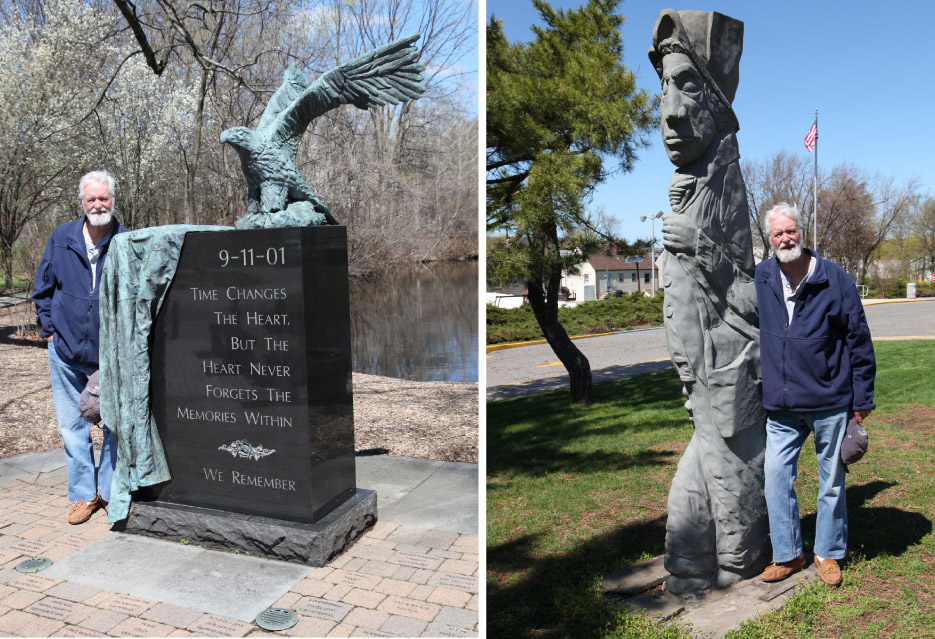 |
|
Above, left: The Eagle Alights 9/11 monument features a bronze eagle and draped flag on a South African Black granite stone. Bertelli created the eagle and the flag, which were then cast in bronze. Eagle Alights is installed in a memorial park in Allendale, New Jersey. “As the Phoenix, beginning to rise again…”
|
Is Talent the Result of Working Hard at Something You Love?
Mike then went to wood, because he couldn’t work well outside and carving stone was so messy. With wood, he could just chip, chip away in the house at night and sweep it up. He bought a chisel set, and still unsure of exactly how to use his new tools, he (literally) tried his hand at carving wood. “I used my hand as a hammer, because I didn’t know anything! Nonetheless, I just kept getting better while doing bigger and bigger pieces. I never quit my day job, continued to raise my children, and at night I would put a piece of wood on my lap and chip away for a few hours at a time. What was different from my job was that I could start it, finish it, and have a sense of accomplishment, unlike working at the family liquor store, where boxes came in the back door, and went out the front door.”
Inspired by all the great artists like Rodin, Michelangelo and Bernini, Mike continued to teach himself by copying these masters. However, he readily admits that this was tough, so he also began making original figurative concepts that were much more fun and creative. No one was looking over his shoulder to direct or correct him, no mentor to look to for encouragement. However, he continued to drive himself, he explained. “In the beginning, when I started learning, I studied anatomy and took measurements when doing figures to exact proportions. But when I started doing creative stuff, I was simply doing it my way. What’s the sense of doing something that everybody else did, you know?
“Whatever I did was unique. It didn’t exist before, and whether it’s worth anything or not, it’s still unique. But I had to learn the hard way. There was no internet then, but somehow I knew what I had to do. I had a sense of what was going right and what was going wrong. If I knew it was wrong, I fixed it.”
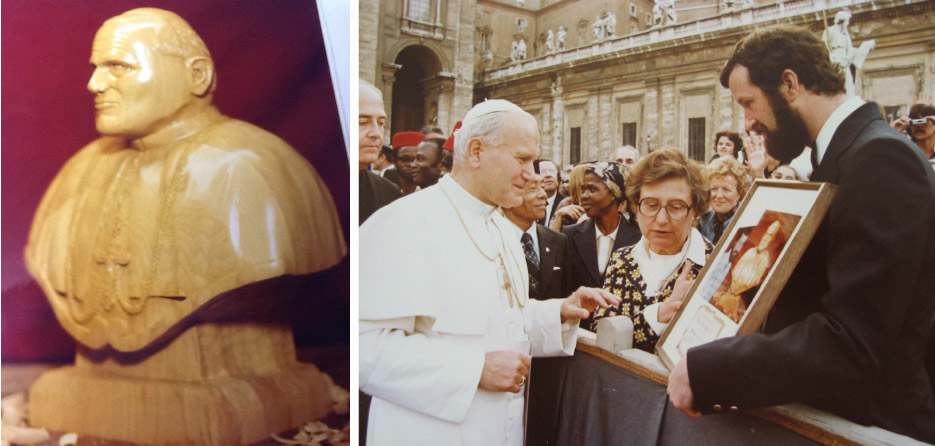 |
|
Above, right: Bertelli meets Pope John Paul II in Vatican Square in 1980 to present his bust of the Pontiff. The sculpture is on permanent display at Boystown of Italy, in Tuscany. |
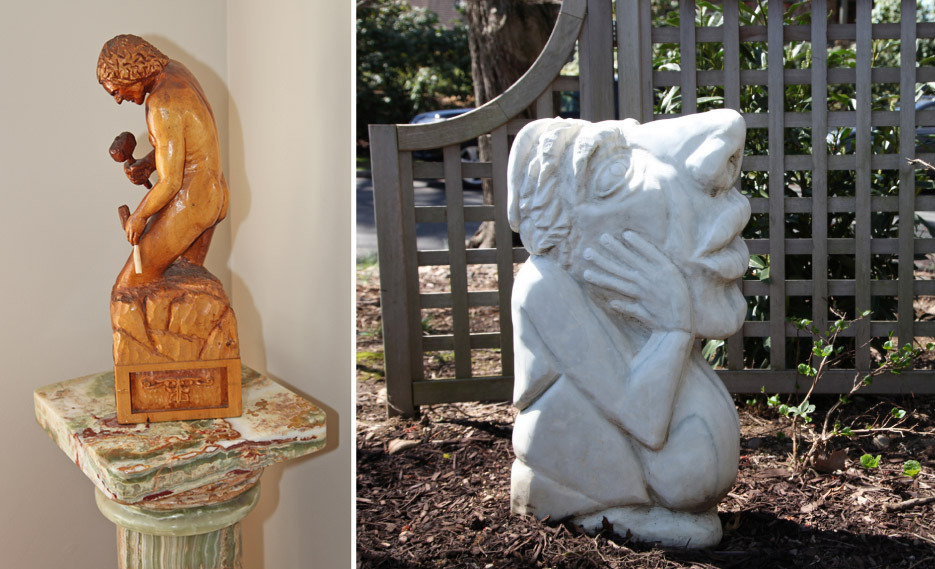 |
|
Above, Left: Gotta Get Outta Here — 22-inch poplar. Bertelli used poplar in his early carving experiments, including the Pope John Paul II sculpture.
|
The Beginning of Bertelli’s Public Art and Commissions
By 1979, through hard work and hands-on study, Mike’s ability to carve faces and bodies in wood in both relief and 3-D had reached a point of excellence. Art aficionados and critics were taking notice, and to his surprise, he got his first commission, he recalled. “I must have been getting pretty good. A federal judge and friend of my father asked me to do a wood carving of Michelangelo’s “Florentine Pieta”, which is a very difficult piece. It was fifteen-inches tall, and it came out really good! How did I do it? Somehow I just did it! It came out so good, that I borrowed the piece back and made a mold so I could do castings of it.”
Mike’s next commission would be in 1980, a wooden bust of Pope John Paul II. “The liquor industry salesman’s union had a pet charity: the Boy’s Town of Italy, located in Tuscany. It was run by Catholic Priests who gave refuge to Italian orphans during and after World War II. They were having a fifty-year anniversary, and the union commissioned me to make a bust of the Pope. It would be presented to the Pope by me, and then wind up at the Boys Town of Italy.” This second commission then led to a third commission for wooden Tabernacle doors carved in relief for the Bethlehem Hermitage, located in Closter, New Jersey.
By 2004, Mike had done all he could do in wood, and went back to carving stone, mostly busts and partial anatomical studies. He then fell into his first large-scale public sculpture, an 11 foot long Bluestone piece he named Passin’ By, installed on the campus lawn of Clifton High School. After anchoring the block in two-foot deep concrete, Mike would carve it after work using simply a hammer, a variety of chisels and a right-angle grinder. No pneumatic tools of any kind were ever used in any of his projects. Passin’ By took 18 months to complete, working 8 to 10 hours per week in good weather, and was one of Mike’s most challenging projects, he explained.
“Before I began Passin’ By, or
before I begin any sculpture project, the first thing I’m thinking is to make it as large as possible, and not make a small sculpture out of a large stone. I want to fully use what I have and take away as little as possible to make a figure. I always want the biggest statue by removing the least amount of stone, because I was making fictional characters who have oversized heads. I would then go to the stone, trying to keep it as big as possible, and try to make a sculpture. I’d start at the nose, and just work my way down, and everything I did from then on was basically original, and before I was done, it’s a magical moment when it’s not a stone anymore, and it’s a figure. I also think that marble is the perfect stone to carve.
I love the look of alabaster, but I’ve never worked with it. Neither sandstone or limestone take a finish like marble and granite, and bluestone is very hard to finish. Passin’ By was a big step for me and very hard to make. I can’t say I had a plan in mind to do it. It just had to happen.”
After Passin’ By, Mike went on to create many other works in stone that would find their home in the City of Clifton, and his current home and hometown of Allendale, New Jersey. He’s also begun the next chapter in his life of creating beauty by learning the unique qualities of painting with watercolor.
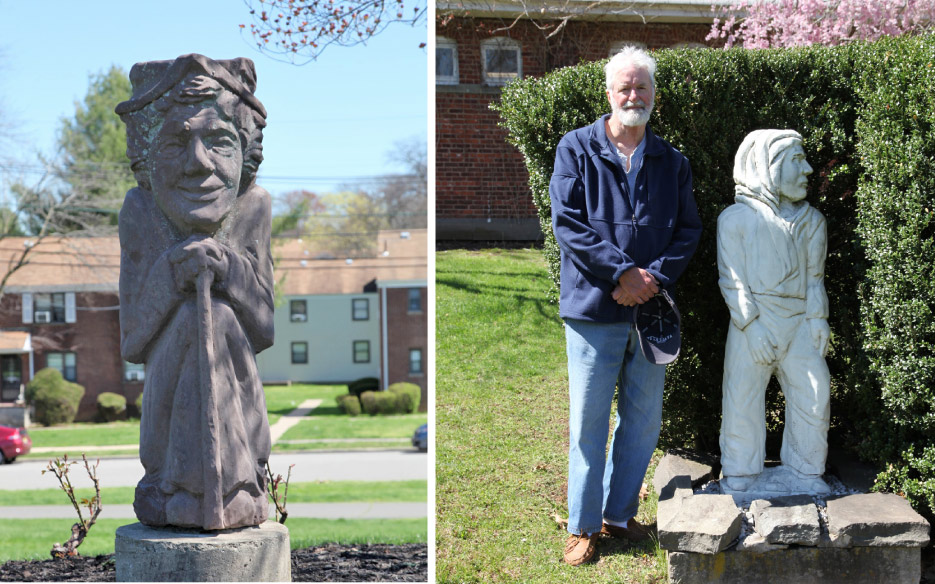 |
|
Above, left: King George. Carved from a 4-foot long brownstone block, using the edge as the front. The king “holds court” in Clifton, New Jersey. Bertelli sourced and repurposed the brownstone from an old, demolished school in Pennsylvania.
|
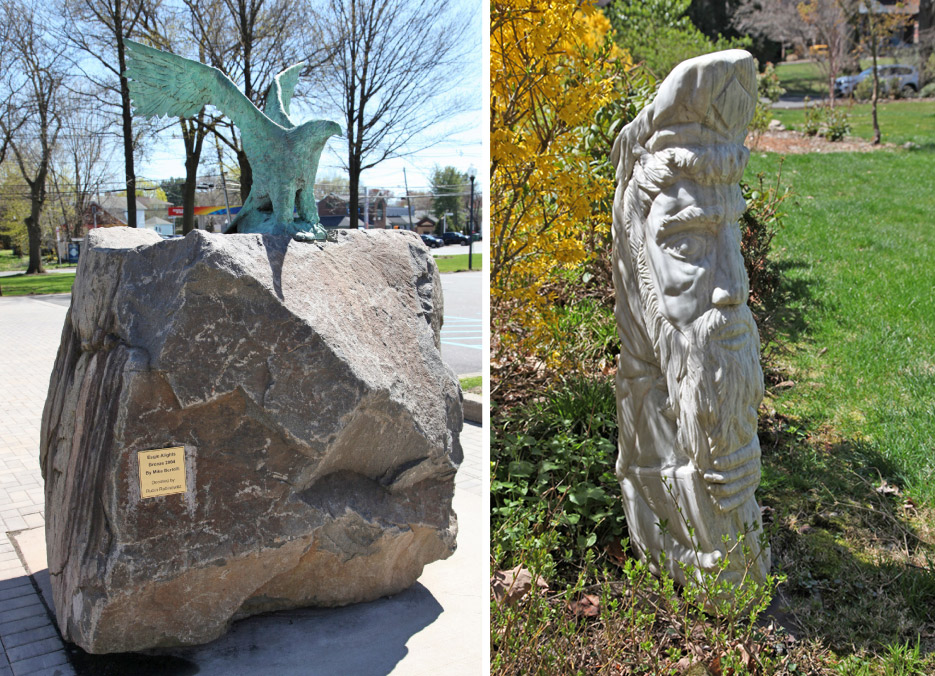 |
|
Above, left: Eagle Alights 2 is a second casting of Bertelli’s original Eagle Alights sculpture. The monument is proudly displayed at the municipal complex in Clifton.
|
Closing Words of Wisdom
“Even though I only paint now, when I’m out walking and see a stone, I look at it differently than I used to years ago. When I look back at what I’ve done, I still get a feeling of accomplishment. I love to see my work in public places, and that’s part of why I loved sculpting. Looking back and thinking I could have majored in art in high school or college, I think, ‘Wow!’ But I didn’t think I had any talent, back then. However, when I picked up that newspaper article in 1971, I thought, ‘Gee! I can learn this!’ And that’s really how I got started.
“As for encouraging others looking to begin a career in the art world, it’s not what you are, it’s what you do and what you want to accomplish. As an artist, you can chase after the marketplace, and if you’re smart you’ll know what sells, or you can try to be completely creative and perhaps you’ll be successful professionally. In other words, if you go one way, you’re going to cater to what sells, and if you go the other way, you’re probably going to be eating cheese sandwiches; not ham and cheese, but you’re going to be doing what you love to do. It’s hard to do both.”
To see more of Mike’s work, including an eclectic collection of clay figures, or to contact him, go to www.mikebertelli.org .